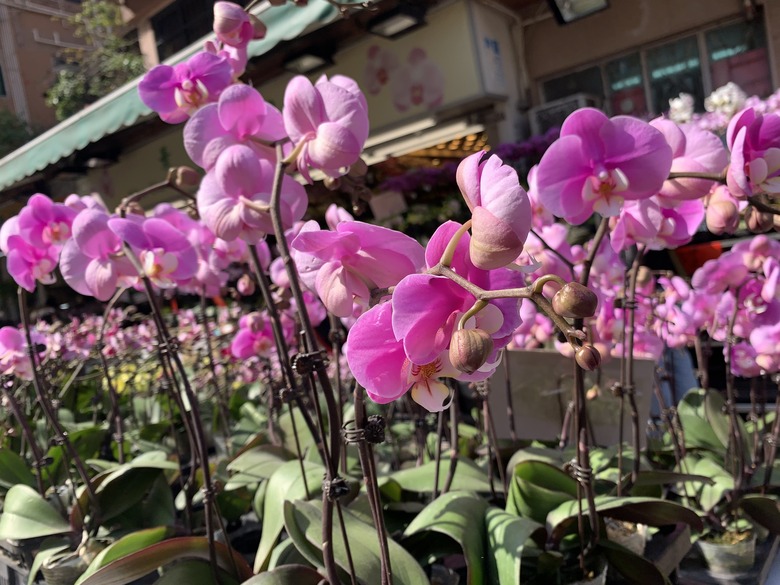How To Replant A Cut Orchid Stem
We may receive a commission on purchases made from links.
Plants in the orchid family (Orchidaceae) are hardy in U.S. Department of Agriculture plant hardiness zones 3 through 12, depending on the species and cultivar. In general, you cannot replant a cut orchid stem to make a new plant. Instead, orchids are propagated by dividing pseudobulbs and rhizomes or planting offshoots, also known as "keikis."
About the Orchid Family
About the Orchid Family
Of the 20,000 to 30,000 orchid species, approximately 70 percent are epiphytic plants. They grow on other plants, like rainforest trees, but are not parasites. Among the many epiphytic orchids grown as houseplants are plants in the Cattleya genus, hardy in USDA zones 10 through 12, and the Dendrobium and Oncidium genera, hardy in USDA zones 9 through 12.
Moth orchids (Phalaenopsis spp.), hardy in USDA zones 10 through 12, are the easy-care epiphytic orchids found in garden centers and grocery stores. These orchids thrive in bright filtered light and temperatures between 60 and 85 degrees Fahrenheit. The delicately arching stems feature multiple blossoms that can last for months.
Terrestrial orchids like the lady slippers (Cypripedium spp.) are cold-hard orchids that are perennials in USDA zones 3 through 8. Unlike their tropical cousins, lady slippers grow into large clumps on rich, moist, well-draining soil in light or dappled shade. These hardy orchids may be propagated from seeds, but they need the help of a soil fungus (Rhizoctonia genus) to germinate. It's best not to dig, divide, and transplant lady slipper orchids, because they grow symbiotically with soil-dwelling Rhizoctonia fungi. When you sever this relationship by removing lady slippers from the native soil, plants struggle to survive transplanting.
Sterilize Cutting Tools
Sterilize Cutting Tools
Orchids are susceptible to viruses and other plant diseases. Sterilize your cutting tools by wiping the blades with rubbing alcohol before making each cut. You can also dip the blades in alcohol instead of wiping them.
Always wear gloves and safety glasses when using cutting tools. Add a mask when working with potting soils, compost, bark, fertilizer and other products to protect your lungs.
Propagate From an Orchid Stem
Propagate From an Orchid Stem
Keikis may develop on the flower spikes of moth orchids as well as Cattleyas and Dendrobiums. When these little plantlets appear, allow them to grow until the roots are 1 to 3 inches long, and the baby plant has two or more leaves. Cut the stem with a sharp knife or pruner 1 inch above and 1 to 2 inches below the keiki. Plant on fresh orchid mix using the stem to anchor the keiki or add a stake to keep it stable in the pot.
Keep the new orchid plant in bright, filtered light and mist regularly. Water once or twice a week and fertilize with one-half to one-quarter strength orchid fertilizer. A keiki may take three years or more to mature and develop flower spikes.
Divide Orchid Plants
Divide Orchid Plants
Orchids that grow from rhizomes or rhizomatous roots, such as Cattleyas, can be divided like any other houseplant in spring. Water thoroughly and then slide the orchid from its pot. Rinse the potting mix from the roots and then divide the roots so each section has roots and at least one pseudobulb or stem. Dust the cut ends with a fungicide and repot in fresh orchard mix.
Replant a Cut Orchid Stem
Replant a Cut Orchid Stem
There's an exception to every rule, and a few of the Dendrobiums are "it" when it comes to rooting from cuttings. The long stems, or pseudobulbs, can be cut from a parent plant, like the Noble Dendrobium (Dendrobium nobile, zones 11-12). Cut each stem into sections containing three to four nodes each.
Fill a tray with moist peat moss and lay the sections horizontally on top. Cover the tray with plastic wrap and set it on a seedling heat mat to keep the cuttings at a consistent temperature of 75 to 85 degrees Fahrenheit. Mist regularly with water to keep the cut stems moist. Fertilize with diluted, one-quarter-strength liquid nitrogen fertilizer biweekly and similarly diluted 6-6-8 liquid fertilizer on the alternate weeks until roots and leaves appear. Replant in small flowerpots and place them in a warm, brightly lit location.
